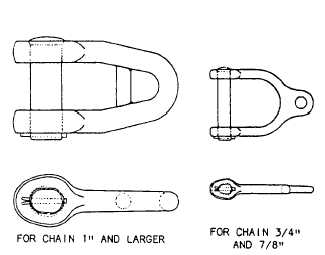| |
are used to hold the anchor taut in the hawsepipes, to
ride to an anchor, or to hold the anchor when the anchor
chain is disconnected for any reason.
When in use, a stopper is attached to the anchor
chain by passing the tongue over a link of the chain and
securing it by engaging the bail of the Pelican hook and
passing a toggle pin. When riding to anchor with more
than one stopper on the chain, the strain must be
equalized in the stoppers by adjusting the settings of the
turnbuckles. Large chain stopper wrenches are used for
this purpose. Special housing chain stoppers, such as
devil's claw or pawl-type stoppers, normally are used
with horizontal windlasses and where space limitations
do not permit use of Navy standard stoppers. Although
stoppers alone are more than adequate for holding the
anchor, they should be backed up with the wildcat
brake. Upon anchoring, first the wildcat brake band
should be set up tight, then the stoppers should be
passed. The wildcat should be left disconnected from
the windlass. A Navy standard chain stopper is shown
in figure 4-5.
Towing chain stoppers are similar to riding chain
stoppers and housing chain stoppers except towing
chain stoppers have locking plates added. These locking
plates prevent the towing chain stoppers from
unscrewing when they are subjected to the shock and
vibration loading of the towing hawser. Chapter 581 of
the Naval Ships' Technical Manual has detailed infor-
mation on towing chain stoppers.
Figure 4-6.–Mooring shackles.
Mooring Swivels
Forged steel swivels, with two links attached at
each end, are used to moor with anchors. They are
inserted in the chain outboard of the hawse and serve to
keep the chain from twisting as the ship swings.
Mooring swivels are attached in the chain with the eye
end outboard, or down, to prevent them from hooking
on the outer lip of the hawse when they are heaved back
aboard. However, ships today have large rounded lips
on the hawsepipes, making it unlikely that a reversed
swivel will catch. A mooring swivel is shown in fig-
ure 4-7.
Chain Cable Jacks
Mooring Shackles
Forged steel mooring shackles (fig. 4-6) are used to
attach the anchor chain to mooring buoys. All mooring
shackles, regardless of size, have a standard opening of
7 inches. Mooring shackles are not to be used for any
other purpose.
A cable jack (fig. 4-8), consisting of a lever
mounted on an axle and two wheels, is used to handle
anchor chain of 2 3/4 inches, or larger, in size. It is used
to pick the chain up to pass a chain stopper. A pinch-
point crowbar type of anchor bar is issued for smaller
sizes of chain.
Figure 4-5.–Navy standard chain stopper.
4-6
|


